Being that Vietnam has an extensive amount of freshwater, it’s able to support an impressive array of amphibians. This class of wildlife includes frogs, toads, and salamanders, all of which can be found throughout Vietnam.
The nation’s rugged backcountry, lack of conservation infrastructure, and challenges with illegal logging and wildlife trafficking have all led to a general underestimation of the amphibian biodiversity in the nation.
Many recorded species have virtually no information regarding population status or distribution. While this causes ecologists to lose a bit of sleep, it is an exciting aspect of wildlife tourism in Vietnam. As a visitor to Vietnam’s jungles, forests, and waterways, one can be met with the incredible surprise of many rare or uncommon critters.
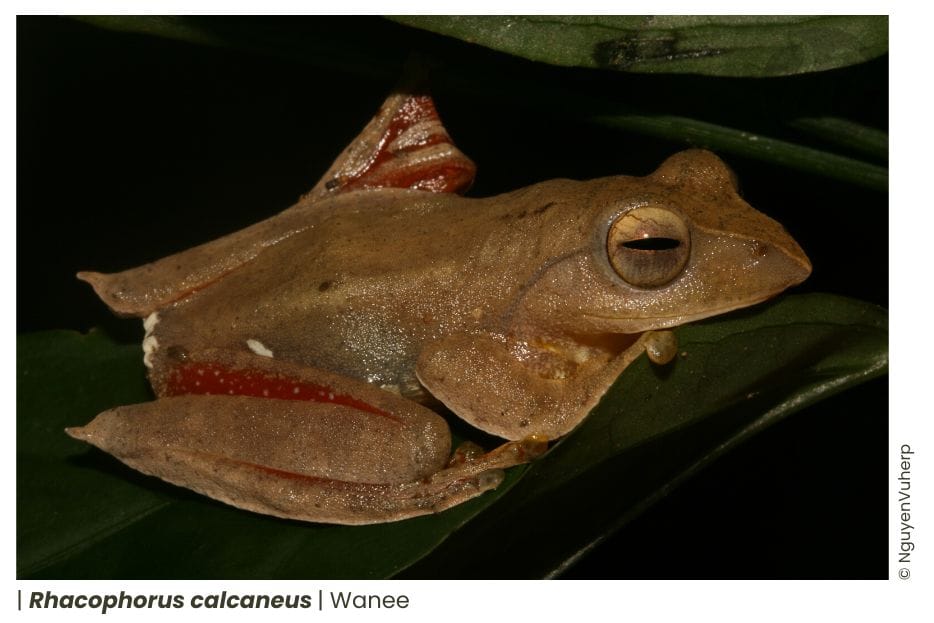
The Amphibians of Vietnam
Up to 10/2022 Vietnam has 295 species of Amphibians With 115 endemic species, we decided to make a list and some of the most interesting, in no particular order to show you.
List of Vietnam’s Amphibians
Source on: https://amphibiansoftheworld.amnh.org/ 10/2022
| No. | English Name | Latinh Name |
| 1 | Hylarana montivaga | |
| 2 | Amolops chunganensis | |
| 3 | Amolops compotrix | |
| 4 | Amolops cremnobatus | |
| 5 | Amolops cucae | |
| 6 | Amolops daorum | |
| 7 | Amolops iriodes | |
| 8 | Amolops mengyangensis | |
| 9 | Amolops minutus | |
| 10 | Amolops ottorum | |
| 11 | Amolops shihaitaoi | |
| 12 | Amolops spinapectoralis | |
| 13 | Amolops tonkinensis | |
| 14 | Amolops viridimaculatus | |
| 15 | Amolops vitreus | |
| 16 | Amolops wenshanensis | |
| 17 | Amolops yatseni | |
| 18 | Atympanophrys gigantica | |
| 19 | Bombina microdeladigitora | |
| 20 | Boulenophrys brachykolos | |
| 21 | Boulenophrys caobangensis | |
| 22 | Boulenophrys daweimontis | |
| 23 | Boulenophrys fansipanensis | |
| 24 | Boulenophrys frigida | |
| 25 | Boulenophrys hoanglienensis | |
| 26 | Boulenophrys jingdongensis | |
| 27 | Boulenophrys minor | |
| 28 | Boulenophrys palpebralespinosa | |
| 29 | Boulenophrys rubrimera | |
| 30 | Brachytarsophrys feae | |
| 31 | Brachytarsophrys intermedia | |
| 32 | Bufo andrewsi | |
| 33 | Bufo cryptotympanicus | |
| 34 | Bufo gargarizans | |
| 35 | Bufo luchunnicus | |
| 36 | Bufo pageoti | |
| 37 | Chirixalus doriae | |
| 38 | Chirixalus nongkhorensis | |
| 39 | Duttaphrynus melanostictus | |
| 40 | Euphlyctis cyanophlyctis | |
| 41 | Feihyla palpebralis | |
| 42 | Fejervarya limnocharis | |
| 43 | Fejervarya moodiei | |
| 44 | Glyphoglossus guttulatus | |
| 45 | Glyphoglossus molossus | |
| 46 | Glyphoglossus yunnanensis | |
| 47 | Gracixalus ananjevae | |
| 48 | Gracixalus gracilipes | |
| 49 | Gracixalus jinxiuensis | |
| 50 | Gracixalus lumarius | |
| 51 | Gracixalus nonggangensis | |
| 52 | Gracixalus quangi | |
| 53 | Gracixalus quyeti | |
| 54 | Gracixalus sapaensis | |
| 55 | Gracixalus supercornutus | |
| 56 | Gracixalus trieng | |
| 57 | Gracixalus yunnanensis | |
| 58 | Gracixalus ziegleri | |
| 59 | Hoplobatrachus chinensis | |
| 60 | Humerana lateralis | |
| 61 | Hyla annectans | |
| 62 | Hyla chinensis | |
| 63 | Hyla simplex | |
| 64 | Hylarana erythraea | |
| 65 | Hylarana macrodactyla | |
| 66 | Hylarana taipehensis | |
| 67 | Ichthyophis catlocensis | |
| 68 | Ichthyophis chaloensis | |
| 69 | Ichthyophis kohtaoensis | |
| 70 | Ichthyophis nguyenorum | |
| 71 | Ingerophrynus galeatus | |
| 72 | Ingerophrynus macrotis | |
| 73 | Kalophrynus cryptophonus | |
| 74 | Kalophrynus honbaensis | |
| 75 | Kalophrynus interlineatus | |
| 76 | Kaloula indochinensis | |
| 77 | Kaloula mediolineata | |
| 78 | Kaloula pulchra | |
| 79 | Kurixalus appendiculatus | |
| 80 | Kurixalus baliogaster | |
| 81 | Kurixalus banaensis | |
| 82 | Kurixalus bisacculus | |
| 83 | Kurixalus gracilloides | |
| 84 | Kurixalus hainanus | |
| 85 | Kurixalus motokawai | |
| 86 | Kurixalus odontotarsus | |
| 87 | Kurixalus verrucosus | |
| 88 | Kurixalus viridescens | |
| 89 | Leptobrachella aerea | |
| 90 | Leptobrachella applebyi | |
| 91 | Leptobrachella ardens | |
| 92 | Leptobrachella bidoupensis | |
| 93 | Leptobrachella botsfordi | |
| 94 | Leptobrachella bourreti | |
| 95 | Leptobrachella crocea | |
| 96 | Leptobrachella eos | |
| 97 | Leptobrachella firthi | |
| 98 | Leptobrachella graminicola | |
| 99 | Leptobrachella isos | |
| 100 | Leptobrachella kalonensis | |
| 101 | Leptobrachella macrops | |
| 102 | Leptobrachella maculosa | |
| 103 | Leptobrachella melica | |
| 104 | Leptobrachella minima | |
| 105 | Leptobrachella nahangensis | |
| 106 | Leptobrachella namdongensis | |
| 107 | Leptobrachella niveimontis | |
| 108 | Leptobrachella nyx | |
| 109 | Leptobrachella pallida | |
| 110 | Leptobrachella petrops | |
| 111 | Leptobrachella pluvialis | |
| 112 | Leptobrachella puhoatensis | |
| 113 | Leptobrachella pyrrhops | |
| 114 | Leptobrachella rowleyae | |
| 115 | Leptobrachella sungi | |
| 116 | Leptobrachella tadungensis | |
| 117 | Leptobrachella tuberosa | |
| 118 | Leptobrachella ventripunctata | |
| 119 | Leptobrachella yingjiangensis | |
| 120 | Leptobrachium ailaonicum | |
| 121 | Leptobrachium banae | |
| 122 | Leptobrachium chapaense | |
| 123 | Leptobrachium guangxiense | |
| 124 | Leptobrachium leucops | |
| 125 | Leptobrachium lunatum | |
| 126 | Leptobrachium masatakasatoi | |
| 127 | Leptobrachium mouhoti | |
| 128 | Leptobrachium ngoclinhense | |
| 129 | Leptobrachium pullum | |
| 130 | Leptobrachium xanthospilum | |
| 131 | Limnonectes bannaensis | |
| 132 | Limnonectes dabanus | |
| 133 | Limnonectes fastigatus | |
| 134 | Limnonectes gyldenstolpei | |
| 135 | Limnonectes kiziriani | |
| 136 | Limnonectes kohchangae | |
| 137 | Limnonectes nguyenorum | |
| 138 | Limnonectes phuyenensis | |
| 139 | Limnonectes poilani | |
| 140 | Limnonectes quangninhensis | |
| 141 | Limnonectes taylori | |
| 142 | Microhyla aurantiventris | |
| 143 | Microhyla berdmorei | |
| 144 | Microhyla butleri | |
| 145 | Microhyla daklakensis | |
| 146 | Microhyla darevskii | |
| 147 | Microhyla fissipes | |
| 148 | Microhyla heymonsi | |
| 149 | Microhyla minuta | |
| 150 | Microhyla neglecta | |
| 151 | Microhyla ninhthuanensis | |
| 152 | Microhyla picta | |
| 153 | Microhyla pineticola | |
| 154 | Microhyla pulchra | |
| 155 | Micryletta erythropoda | |
| 156 | Micryletta inornata | |
| 157 | Micryletta melanops | |
| 158 | Micryletta menglienica | |
| 159 | Micryletta nigromaculata | |
| 160 | Nanohyla annamensis | |
| 161 | Nanohyla arboricola | |
| 162 | Nanohyla hongiaoensis | |
| 163 | Nanohyla marmorata | |
| 164 | Nanohyla nanapollexa | |
| 165 | Nanohyla pulchella | |
| 166 | Nanorana aenea | |
| 167 | Nanorana yunnanensis | |
| 168 | Nidirana chapaensis | |
| 169 | Nidirana lini | |
| 170 | Occidozyga lima | |
| 171 | Occidozyga martensii | |
| 172 | Odorrana absita | |
| 173 | Odorrana andersonii | |
| 174 | Odorrana bacboensis | |
| 175 | Odorrana banaorum | |
| 176 | Odorrana chapaensis | |
| 177 | Odorrana chloronota | |
| 178 | Odorrana fengkaiensis | |
| 179 | Odorrana geminata | |
| 180 | Odorrana gigatympana | |
| 181 | Odorrana grahami | |
| 182 | Odorrana graminea | |
| 183 | Odorrana jingdongensis | |
| 184 | Odorrana junlianensis | |
| 185 | Odorrana khalam | |
| 186 | Odorrana lipuensis | |
| 187 | Odorrana margaretae | |
| 188 | Odorrana morafkai | |
| 189 | Odorrana mutschmanni | |
| 190 | Odorrana nasica | |
| 191 | Odorrana orba | |
| 192 | Odorrana tiannanensis | |
| 193 | Odorrana trankieni | |
| 194 | Odorrana yentuensis | |
| 195 | Ophryophryne elfina | |
| 196 | Ophryophryne gerti | |
| 197 | Ophryophryne microstoma | |
| 198 | Ophryophryne pachyproctus | |
| 199 | Ophryophryne poilani | |
| 200 | Ophryophryne synoria | |
| 201 | Ophryphryne hansi | |
| 202 | Oreolalax sterlingae | |
| 203 | Papurana attigua | |
| 204 | Papurana milleti | |
| 205 | Paramesotriton deloustali | |
| 206 | Paramesotriton guangxiensis | |
| 207 | Philautus abditus | |
| 208 | Philautus catbaensis | |
| 209 | Philautus maosonensis | |
| 210 | Phrynoidis asper | |
| 211 | Polypedates braueri | |
| 212 | Polypedates colletti | |
| 213 | Polypedates impresus | |
| 214 | Polypedates megacephalus | |
| 215 | Polypedates mutus | |
| 216 | Pulchrana glandulosa | |
| 217 | Quasipaa acanthophora | |
| 218 | Quasipaa boulengeri | |
| 219 | Quasipaa courtoisi | |
| 220 | Quasipaa delacouri | |
| 221 | Quasipaa spinosa | |
| 222 | Quasipaa taoi | |
| 223 | Quasipaa verrucospinosa | |
| 224 | Rana johnsi | |
| 225 | Raorchestes gryllus | |
| 226 | Raorchestes longchuanensis | |
| 227 | Raorchestes menglaensis | |
| 228 | Raorchestes parvulus | |
| 229 | Rhacophorus annamensis | |
| 230 | Rhacophorus bipunctatus | |
| 231 | Rhacophorus calcaneus | |
| 232 | Rhacophorus exechopygus | |
| 233 | Rhacophorus helenae | |
| 234 | Rhacophorus hoabinhensis | |
| 235 | Rhacophorus hoanglienensis | |
| 236 | Rhacophorus kio | |
| 237 | Rhacophorus larissae | |
| 238 | Rhacophorus marmoridorsum | |
| 239 | Rhacophorus orlovi | |
| 240 | Rhacophorus rhodopus | |
| 241 | Rhacophorus robertingeri | |
| 242 | Rhacophorus trangdinhensis | |
| 243 | Rhacophorus vanbanicus | |
| 244 | Rhacophorus viridimaculatus | |
| 245 | Rohanixalus vittatus | |
| 246 | Romerus calcarius | |
| 247 | Romerus feii | |
| 248 | Sylvirana annamitica | |
| 249 | Sylvirana cubitalis | |
| 250 | Sylvirana guentheri | |
| 251 | Sylvirana maosonensis | |
| 252 | Sylvirana montosa | |
| 253 | Sylvirana nigrovittata | |
| 254 | Theloderma albopunctatum | |
| 255 | Theloderma annae | |
| 256 | Theloderma asperum | |
| 257 | Theloderma auratum | |
| 258 | Theloderma bicolor | |
| 259 | Theloderma corticale | |
| 260 | Theloderma gordoni | |
| 261 | Theloderma hekouense | |
| 262 | Theloderma khoii | |
| 263 | Theloderma laeve | |
| 264 | Theloderma lateriticum | |
| 265 | Theloderma nebulosum | |
| 266 | Theloderma palliatum | |
| 267 | Theloderma petilum | |
| 268 | Theloderma ryabovi | |
| 269 | Theloderma truongsonense | |
| 270 | Theloderma vietnamense | |
| 271 | Tylototriton anguliceps | |
| 272 | Tylototriton pasmansi | |
| 273 | Tylototriton sparreboomi | |
| 274 | Tylototriton thaiorum | |
| 275 | Tylototriton vietnamensis | |
| 276 | Tylototriton ziegleri | |
| 277 | Vampyrius vampyrus | |
| 278 | Vietnamophryne cuongi | |
| 279 | Vietnamophryne inexpectata | |
| 280 | Vietnamophryne orlovi | |
| 281 | Vietnamophryne vuquangensis | |
| 282 | Xenophrys maosonensis | |
| 283 | Xenophrys pachyproctus | |
| 284 | Xenophrys truongsonensis | |
| 285 | Zhangixalus dennysi | |
| 286 | Zhangixalus dorsoviridis | |
| 287 | Zhangixalus duboisi | |
| 288 | Zhangixalus dugritei | |
| 289 | Zhangixalus feae | |
| 290 | Zhangixalus franki | |
| 291 | Zhangixalus hungfuensis | |
| 292 | Zhangixalus jodiae | |
| 293 | Zhangixalus nigropunctatus | |
| 294 | Zhangixalus pachyproctus | |
| 295 | Zhangixalus puerensis |
Frogs and Toads in Vietnam
The moist forests, vast wetlands, and considerable changes in elevation throughout Vietnam have produced one of the world’s best habitats for frog and toad species. Just don’t try to find your Prince Charming or you might end up in the emergency room.
Yunnan Spiny Frog
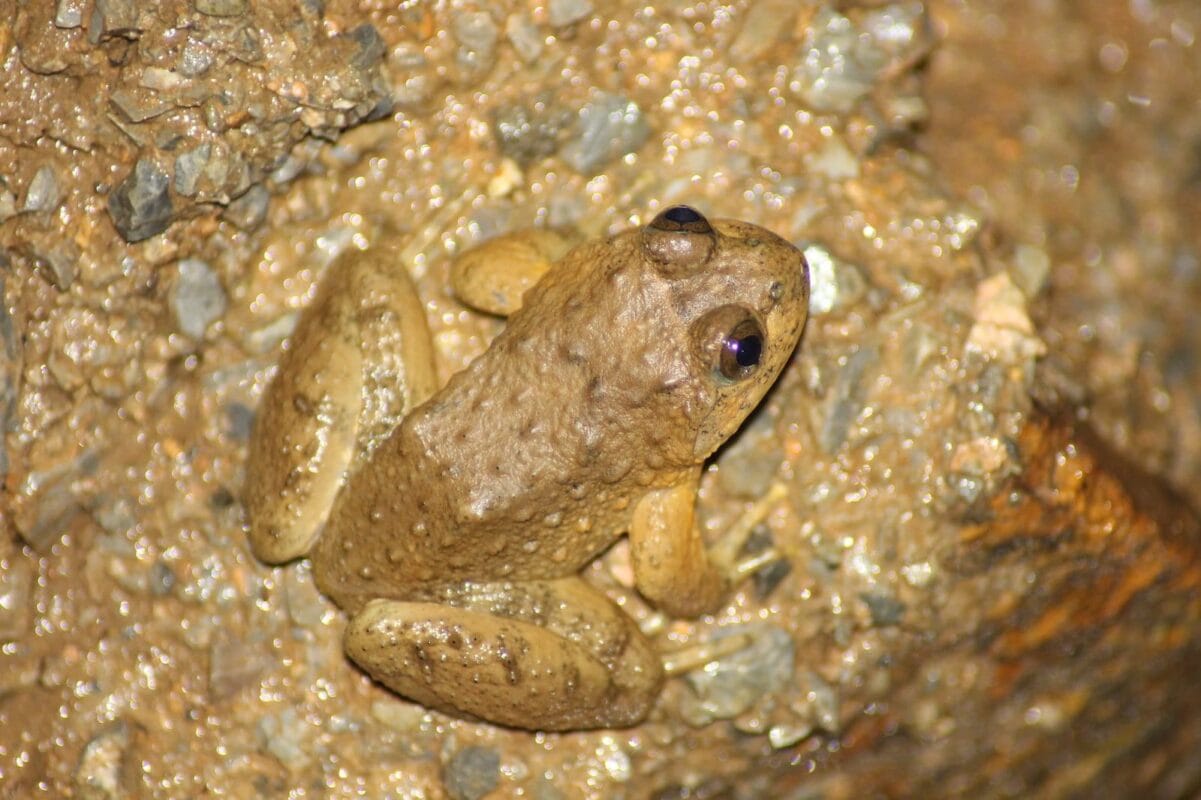
Having brown and blackish skin with small yellow/brown nodules all over, the Yunnan Spiny Frog is a rather bland-looking critter. If you ask a local about it, though, they’ll likely tell you that this frog used to be on a dinner menu just down the street. Yunnan Spiny Frogs are listed as endangered IUCN due to over-harvesting and over-consumption by humans.
Males can grow up to 10 cm in length and their preferred habitat is moss-covered rocks around the river and creek beds. Spotting one is becoming a less common occurrence, so you’ll have to look carefully if you’re hoping to find one in the wild. Between April and June, you can find their eggs in shallow creeks.
Vampire Flying Frog
One of the coolest and most impressive animals in all of Vietnam, the Vampire Flying Frog lives up to its name. High up in Vietnam’s “cloud forests”, the climate is entirely different from the stereotypical heat and humidity of the jungle forests. Here, the ground is virtually always moist and it produces year-round fungal buildup, perfect for fanged (yes, fanged) Vampire Flying Frogs.
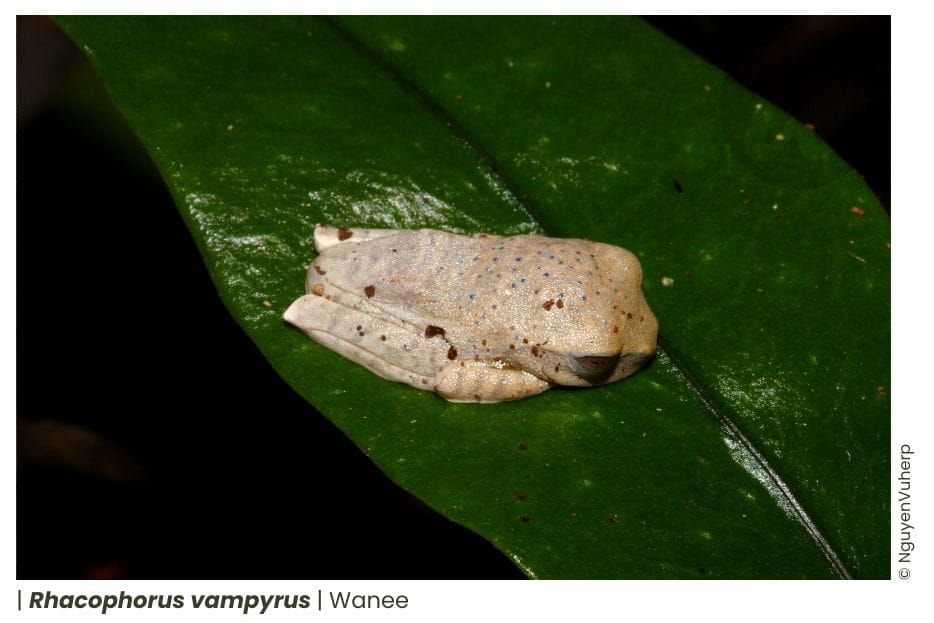
As tadpoles, this species carries sharp black fangs, something unseen in any other frog species. Theories as to why they’ve evolved to have such a trait range from feeding expertise to wild folklore. Unfortunately, these frogs are endemic to a very limited region of Vietnam’s high elevation forests, and thus, are under increasing pressure due to climate change and habitat loss.
Helen’s Tree Frog
Much like the Vampire Flying Frog, the Helen’s Flying Frog was recently discovered and carries similar attributes in that its main defense mechanism is the ability to glide long distances in the air.
These frogs are known for their bright green coloration, relatively massive webbed hands and feet, and large arms that give them an extra ability to glide freely through the canopy. Relying on lowland forests near wetlands, their populations are under direct and imminent threats from logging and development.
Thorny Tree Frog
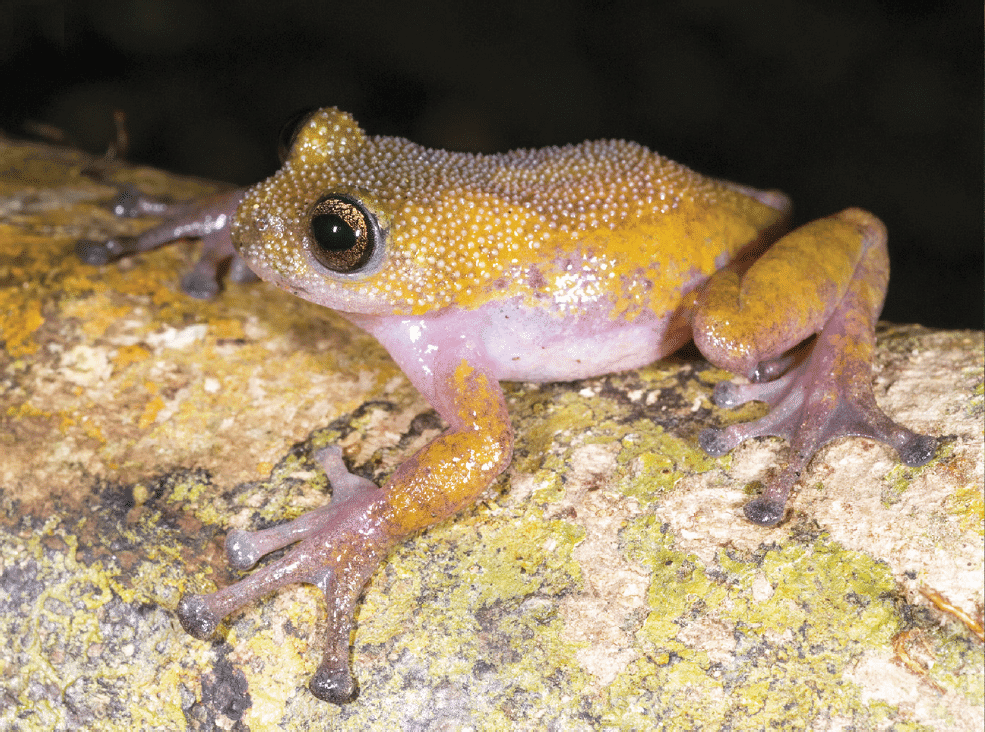
Perhaps the most unique frog in Vietnam, the Thorny Tree Frog has blazed its own path of survival in Vietnam’s sharp, cold mountainsides. Its pink and white coloration is complemented by a layer of white spine-like structures that grow during the breeding season (for the males).
While known for its alien-like appearance, the Thony Tree Frog’s uncommon method of incubation has also captivated scientists. In Vietnam’s moist mountain forests, trees often snap leaving short hollow stumps that quickly fill with water. The frogs will lay their eggs in these isolated breeding pools, providing an extra layer of protection against predators.
Vietnamese Mossy Frog
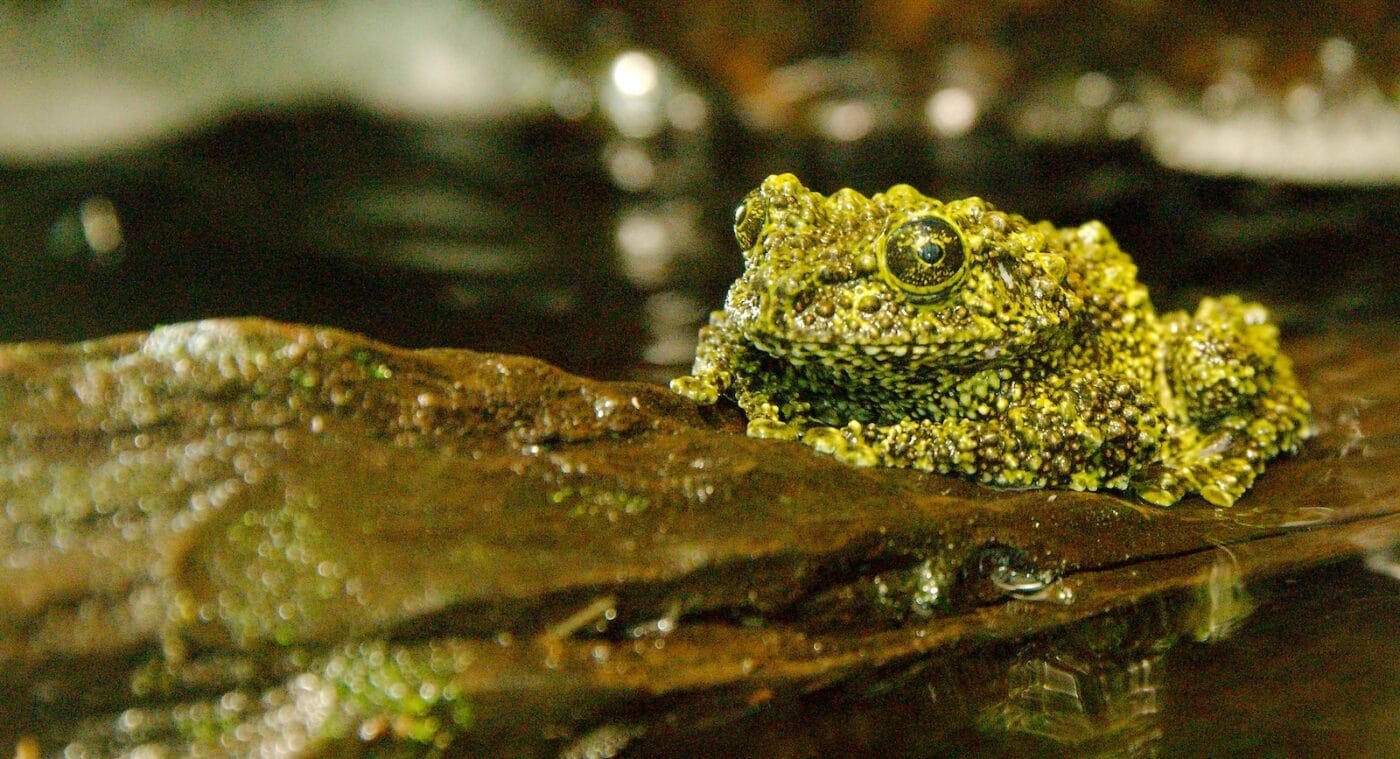
Decked out in camouflage, the Vietnamese Mossy Frog has some strikingly unique characteristics. Most often found in small cave-like crevices along Vietnam’s limestone cliff-sides, they attach themselves to rock formations in order to appear as though they are moss growth.
Hunting mainly insects, they also have interesting defense mechanisms which include rolling into a ball in hopes that predators will assume they are simply a clump of foliage. They also have an uncanny ability to “throw” their voices long distances, which is an act of deception making the exact location of their current standing almost impossible to predict.
Frogs of Mount Fansipan
With unique features come unique habitats, Mount Fansipan has been identified as a specific location of rich biodiversity and imminent conservation needs. The amphibians of Fansipan face uncertain futures as climate change drives environmental shifts that often cause upward migration of other species, including potential new predators.
Mao-Son Horned Frog
This grumpy-looking Mao-Son Horned Frog is found in two distinct regions: the south of China and the Fansipan ecoregion. Not only is it an important species to the Fansipan ecosystem but it also provides herpetologists and conservationists with insight into amphibian protection.
The Mao-Son Horned Frog, known for its brawny eyebrow-like horned ridges above its eyes, has tadpoles that have very different appearances from typical tadpoles. This means that identifying this species at this stage is possible.
Ailao Moustache Toad
The Ailao Moustache Toad (Leptobrachium ailaonicum) develops a row of sharp spine-like features above their mouths, an armored mustache, that they use in defense of their eggs against other males. It’s also known as the Ailao spiny toad, Ailao moustache toad, or Yunnan moustache toad.
Sterling’s Toothed Toad
The Sterling’s Toothed Toad is one of the world’s most endangered frog species. Its huge back legs and large protruding eyes give it a striking appearance. Traditionally it was thought that this species was endemic to a tiny portion of high elevation cloud forest in Vietnam.
However, it’s been found that the species is either adapting to lower elevation habitats or has dispersed previously into multiple varying ecological niches. This is great news for a frog species that was thought to be on the brink of extinction just a few years ago.
Newts and Salamanders in Vietnam
Vietnam’s mountains cut through humid jungles and create an incredible layered system of habitats that includes countless cold-running creeks and rivers where newts and salamanders are most at home. Like the rest of Vietnam’s biodiversity, the last decade has seen both alarming declines in populations and exciting new discoveries of previously unknown species of newts and salamanders.
Tom Dao Salamander (The Vietnamese Salamander)
The Tom Dao Salamander‘s rusty orange appearance makes it look like a miniature prehistoric lizard. One of Vietnam’s most popular endemic species, it has unfortunately been subjected to widespread capture, breeding, and trafficking as a pet or even as a flavoring for alcoholic drinks.
Newts, like most amphibian species, provide forests with a gauge of ecosystem health and as the Tom Dao Newt continues to decline, it will become harder and harder for Vietnamese people to rely on natural indicators of forest health.
Vietnamese Crocodile Newt
The crocodile newt is the richest genus of Newts in the world, with Vietnam being home to a few very unique species of crocodile newts, like the Vietnamese Crocodile Newt. This small charred-black colored newt thrives in dense bamboo forests placed near creeks, ponds, or river beds.
The shrinking availability of dense undisturbed bamboo forests and water quality are increasingly becoming status issues for the Vietnamese Crocodile Newt. Their almost fully black appearance has traditionally made it difficult to differentiate them from other species in the same genus, such as the Ziegler’s Crocodile Newt.
Ziegler’s Crocodile Newt
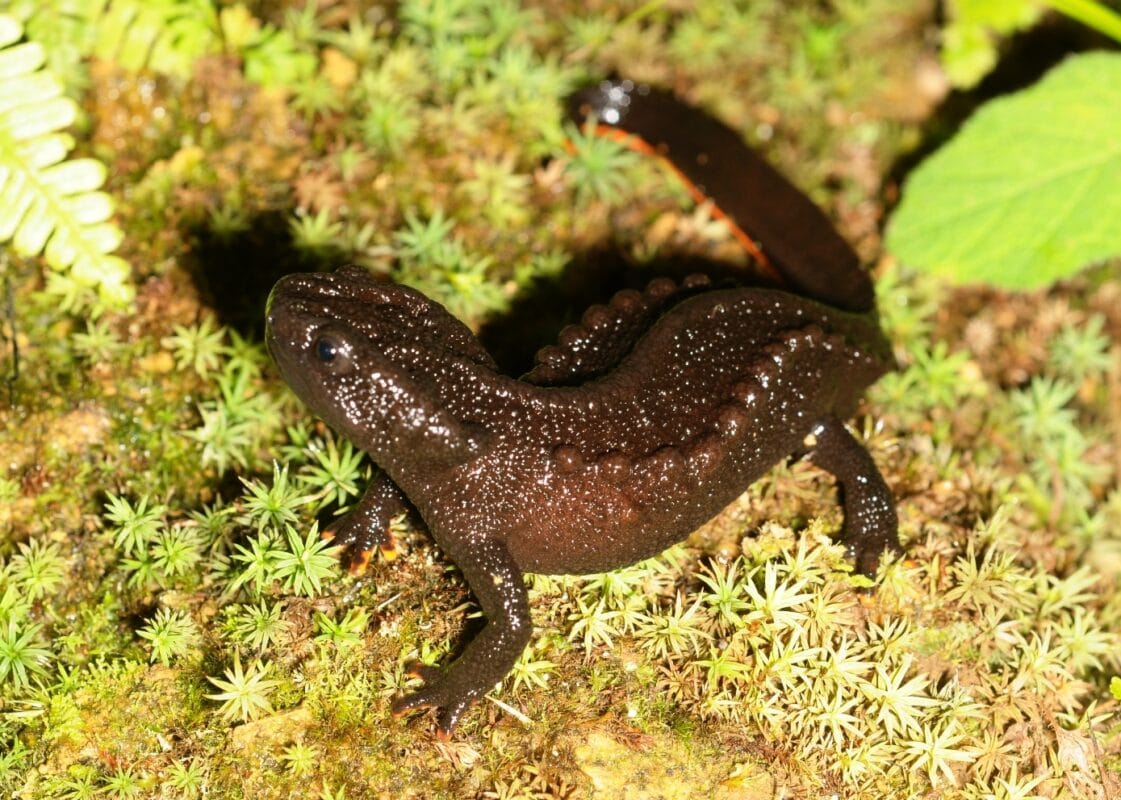
Given the nickname “the amphibian from hell” due to its dark black coloration, this newt looks and acts very similarly to the Vietnamese Crocodile Newt. It’s a bit smaller, darker, and has some general morphological differences, like different patterns of ridges on its back and orange-tipped fingers and toes.
While some newts are water-based for much of the year, this newt uses the water for breeding season and then spends most of its time near water but not in it.
Himalayan Newt
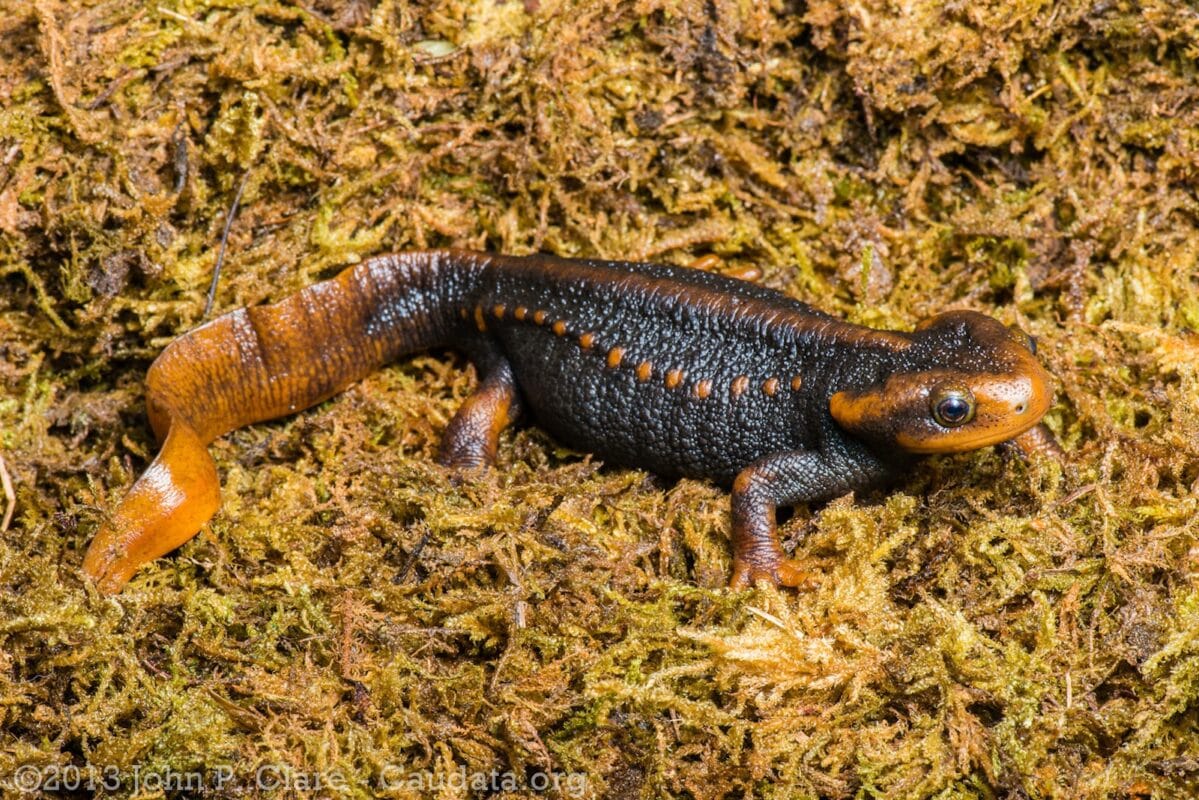
The Himalayan Newt has a widespread distribution in high elevation forests across Southeast Asia and India. Its dark purple, orange, or ruby coloring as an adult gives it a fairly unique appearance compared to other newts of the region. Unlike some of Vietnam’s fragile endemic species, the Himalayan Newt is resilient to habitat changes and variations.
In the country’s mountain forests or high elevation farmlands, these little guys can be found both near to and far from human presence.
Black-knobby Newt
The Black-knobby Newt is particularly sensitive to anthropogenic disturbances and is, therefore, extremely difficult to find in the mountain habitats of northern Vietnam. It is also a mainly terrestrial newt and relies on small, moist crevices within bamboo forests to burrow and forage.
It follows in the other crocodile newts’ footsteps in that it is dark black with some bright orange highlights. But it has a more defined spinal ridge and its size varies.
Important Members of the Food Chain
Oftentimes in Vietnam, amphibians will be grouped together for decades and identified as a single species when in fact, the observed animals are of many different species and sub-species. The incredible habitats of Vietnam support one of the world’s most rich pools of species, and for those who wish to see them, you should head to the mountain forests and lowland areas.
Dalat Plateau Birding Herping and Wildlife Tours
The Dalat Plateau, rising 2,000 meters above sea level, is one of Vietnam’s most important [...]
Cat Tien National Park Birding Herping and Wildlife Tours
Cat Tien National Park tours offer an unforgettable experience with sightings of Germain’s Peacock Pheasant, [...]
Western Black Crested Gibbon – Nomascus concolor
Nestled within the verdant landscapes of Vietnam, the Western Black Crested Gibbon (Nomascus concolor) emerges [...]
Northern White-cheeked Gibbon – Nomascus leucogenys
The northern white-cheeked gibbon (Nomascus leucogenys) is a Critically Endangered gibbon species indigenous to South [...]
Northern Yellow-cheeked Crested Gibbon – Nomascus annamensis
The Northern Yellow-Cheeked Crested Gibbon, or Nomascus annamensis, is an exclusive primate species found in [...]
Eastern Black Crested Gibbon – “Cao-vit Gibbon” – Nomascus nasutus
Nestled within the dense, emerald-green forests of Vietnam, the Eastern Black Crested Gibbon (Nomascus nasutus), [...]